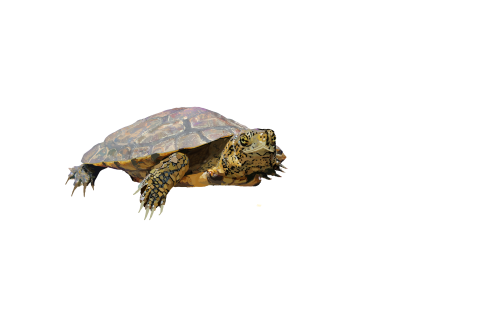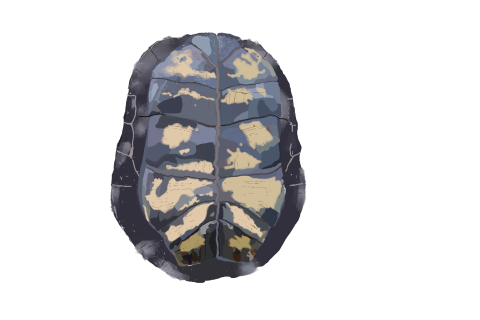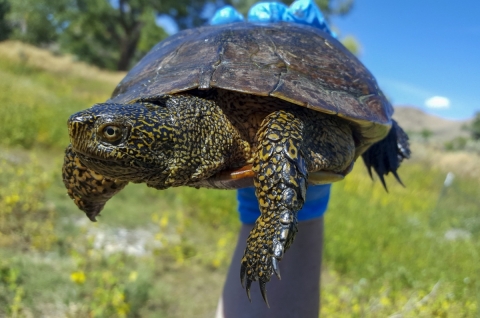The following information is the text version of the information displayed in the Saving a Rapidly Vanishing Turtle infographic. See the original here.
Western pond turtles are made up of two species, the southwestern pond turtle and northwestern pond turtle. Western pond turtles range from Puget Sound, Washington, in the north to northwestern Baja California, Mexico, in the south. Both populations were proposed for listing as threatened under the Endangered Species Act in 2023 due worsening drought conditions, habitat loss and fragmentation, and predation by invasive species invasive species
An invasive species is any plant or animal that has spread or been introduced into a new area where they are, or could, cause harm to the environment, economy, or human, animal, or plant health. Their unwelcome presence can destroy ecosystems and cost millions of dollars.
Learn more about invasive species such as non-native bullfrogs.
Behaviors
Sunbathing
Westing pond turtles love to sunbathe! They are more abundant in places that include logs, stumps, rock piles, floating vegetation, and clumps unattached to shoreline or land where they can bask in the sun.
Feeding
These turtles aren’t too picky in their diets, they are omnivores that like to eat larvae, crustaceans, worms, and aquatic vegetation.
Overwintering
Western pond turtles don’t hibernate, they brumate! That means they aren’t fully asleep, and can wake up mid-winter to look for food or move around
Threats
The biggest threat to the species are introduced predators such as bullfrogs and warm freshwater fish, such as bass, which both prey on small juvenile turtles. Populations of western pond turtles are also facing decline due to the emergence of shell disease and the destruction of their native upland and aquatic habitat.
Habitat
Western pond turtles spend most of their lives in water, but they also require terrestrial habitats for nesting.
These turtles can be found living in streams, ponds, lakes, and wetlands across western United States and Baja California, Mexico.
Nesting
The hole is first filled with loose vegetation or dirt, then covered with wet soil to keep the eggs in a humid environment. The eggs incubate naturally underground for 90-130 days.
From late May until mid-July, females dig a hole for the nest, softening the soil with urine, and then scooping out the soil using her hind feet. Once the site is prepared, she deposits a clutch of 3 to 13 eggs.
Conservation Efforts
Read about just a few of the projects being done to help save the northwestern and southwestern pond turtle from extinction in western United States.
California
The Santa Clara Valley Habitat Conservation Plan and Natural Community Conservation Plan (HCP/NCCP) has preserved over 6,000 acres of suitable habitat for the western pond turtle. Of those, over 1,500 acres are considered primary habitat, such as ponds, streams, canals, ditches, and coastal and valley freshwater marsh.
The Santa Clara Valley HCP/NCCP is also required to restore streams and ponds for the benefit of covered species including the western pond turtle, California red-legged frog, and California tiger salamander. Some of these restoration projects include the following:
Pacheco Creek Restoration Project began construction began in July 2023 to increase the stream habitat complexity for steelhead trout, California red-legged frog, and western pond turtles, create secondary channels, restore sycamore alluvial woodland habitat, and install western pond turtle basking structures in a pond next to the creek.
Pond restoration projects at Calero County Park Preserve and Coyote Ridge Open Space Preserve began in order to increase the hydroperiod for western pond turtles and breeding California tiger salamanders and California red-legged frogs while removing invasive predators (e.g. bullfrogs, crayfish) and installing basking habitat for western pond turtles.
Pond restoration projects at Calero County Park Preserve and Coyote Ridge Open Space Preserve to increase the hydroperiod for western pond turtles and breeding California tiger salamanders and California red-legged frogs while removing invasive predators (e.g. bullfrogs, crayfish) and installing basking habitat for western pond turtles.
Santa Clara County, CA: As mitigation for the Upper Llagas Creek Flood Control Project, restoration for riparian riparian
Definition of riparian habitat or riparian areas.
Learn more about riparian and floodplain habitat at a former gravel mine was started for the benefit of steelhead trout and western pond turtles. The project seeks to create basking habitat in the restored stream, and nesting habitat on an island in the restored stream.Western pond turtles are monitored annually at Stanford University and while population numbers are low, they have remained stable over the past several decades. The greatest threats to local population persistence at Stanford are small population size and isolation, non-native species, road mortality, and climate change climate change
Climate change includes both global warming driven by human-induced emissions of greenhouse gases and the resulting large-scale shifts in weather patterns. Though there have been previous periods of climatic change, since the mid-20th century humans have had an unprecedented impact on Earth's climate system and caused change on a global scale.
Learn more about climate change .The Oakland Zoo raises western pond turtle hatchlings at their Biodiversity Center. Zookeepers take care of baby turtles with plenty of nutrient-rich foods and veterinary care, so they grow in just one year to the size it would take them three or four years to reach in the wild. Then, when the turtles are released into the wild, they are big enough to protect themselves and have a much better chance at survival!
Each summer Oakland Zoo zookeepers team up with biologists and students from Sonoma State University to study the WPT. Out in the field, the Zoo is involved in opportunities including incubating nests and using telemetry equipment to track nesting females. Predator protection netting is put over nest sites or eggs are brought back to the lab for incubation and hatching.
Nevada
From 2016 – 2018, Nevada Department of Wildlife (NDOW) led western pond turtle survey efforts on the Truckee, Carson, and Walker Rivers, as well as a very high frequency telemetry effort on the Carson River. Important demographic and movement information was learned through those efforts, but limitations in funding, equipment, and success capturing individuals in some locations left gaps in knowledge of Nevada’s western pond turtle leading up to the upcoming federal listing decision. In 2023, NDOW is proposing to purchase additional equipment and using updated GPS telemetry to learn more about turtle behavior and increase the quality and quantity of data over multiple seasons. NDOW also plans to use eDNA, which will expand their survey coverage into new reaches of the Carson and Truckee River watersheds, thus providing a better understanding of their distribution in Nevada.
Washington
The Washington Department of Fish and Wildlife and Association of Zoos and Aquarium partners at Woodland Park Zoo in Washington and Oregon Zoo have launched a headstart program to raise western pond turtles in human care to release back into the wild to boost their populations. As a result, the turtle population in WA has grown from as few as 150 in the early 1990s, to more than 1000 at six sites.
Recently, however, a shell disease has been detected in Washington’s wild turtle population and appears to be increasing. The University of Illinois’ Zoological Pathology Program is studying the turtles to better understand what causes them to become sick. The Shedd Aquarium has joined in this effort to help with their laboratory to identify microbes that could be beneficial to the turtles in the headstart environment, giving their caretakes another tool to help save this endangered species.








